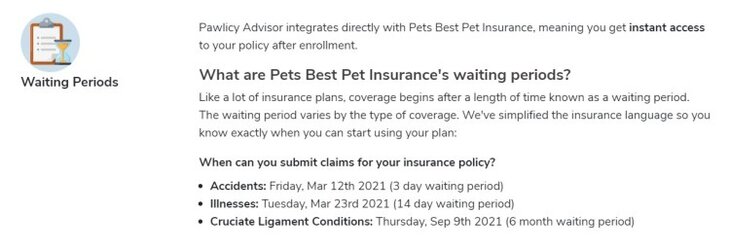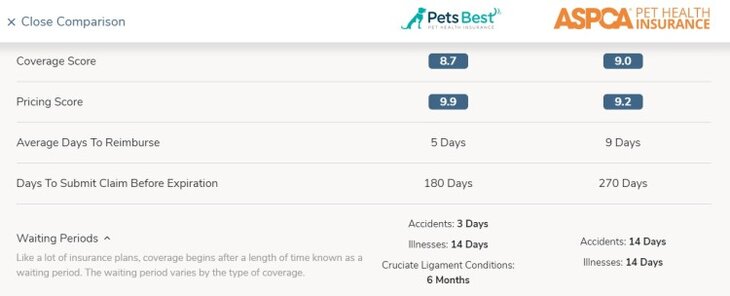How Soon Does Pet Insurance Take Effect?
The best time to sign up for a pet insurance policy is right after you bring your new friend home for the first time. The sooner you get coverage, the better prepared you’ll be if your pet gets sick or injured.
Many pet insurance companies require a certain amount of time for the policy to go into effect after enrollment. Pet parents can’t use their plan or submit claims for reimbursed vet costs until the “waiting period” is over.
Any health condition that arises before the insurance policy goes into effect may be considered “pre-existing” by the insurer. Unfortunately, no provider offers pet insurance for pre-existing conditions and you’ll have to pay for those related costs out of pocket (although you’ll still be eligible for coverage on future health concerns, and have more financial resources you can turn to in the present!)
If you’re wondering how soon pet insurance kicks in, we’ve gathered answers to some common questions about waiting periods. You’ll also learn about free resources that could help you afford the cost of caring for a dog or cat with pre-existing conditions diagnosed before the health insurance took effect.
Pet Insurance Waiting Period by Company: Comparison Chart
The below chart compares pet insurance wait times based on Pawlicy Advisor’s analysis of top pet insurance providers , as well as the figures and language used on each brand’s website.
| Insurance Company | Accident Coverage | Illness Coverage | Preventative Care | Other |
|---|---|---|---|---|
| ASPCA Pet Health Insurance | 14 Days | 14 Days | 0 Days | 14 Days for Knee/Ligament Conditions |
| Embrace Pet Insurance | 2 Days | 14 Days | 0 Days | 6 Months for Orthopedic Conditions (or 14 Days with Orthopedic Exam Waiver) |
| Figo Pet Insurance | Varies | Varies | N/A | Varies by state |
| Hartville Pet Insurance | 14 Days | 14 Days | 0 Days | 14 Days for Ligament Conditions |
| Healthy Paws Pet Insurance | 15 Days | 15 Days | N/A | 12 Months for Hip Dysplasia in Pets Younger than 6 |
| Lemonade Pet Insurance | 2 Days | 14 Days | 0 Days | 6 Months for Cruciate Ligament Conditions |
| Nationwide Pet Insurance | 14 Days | 14 Days | 24 Hours | 12 Months for Cruciate Ligament Conditions |
| MetLife Pet Insurance | Next Day | 14 Days | 0 Days | 12 Months for Cruciate Ligament Conditions |
| Fetch Pet Insurance | 5 Days | 15 Days | 0 Days | 6 Months for Hip Dysplasia, Cruciate Ligament Conditions, and Patellas |
| Pets Best Pet Insurance | Varies* | Varies* | 0 Days | Varies by state* |
| Trupanion Pet Insurance | 5 Days | 30 Days | N/A | 12 Months for Ligament Injuries and Hip Dysplasia. 6 Months for Orthopedic Issues |
| Trusted Pals Pet Insurance | 14 Days | 14 Days | 0 Days | 12 Months for Hip Dysplasia and Ligament Conditions |
| USAA Pet Insurance | 2 Days | 14 Days | 0 Days | 6 Months for Orthopedic Conditions (or 14 Days with Orthopedic Exam Waiver) |
As you can see, some plans provide accident coverage as soon as the next day, whereas others require you to wait 14 days before insurance coverage kicks in. Most providers that offer a wellness add-on offer coverage immediately.
Remember, waiting periods are just one aspect of a pet insurance plan to consider. When you compare pet insurance companies, you should also factor in considerations like the average time to process claims, ease of use, and cost per month.
Can I use pet insurance right away?
For most traditional accident/illness pet insurance policies, you won’t be able to submit a claim right away. Policies may require you to wait up to 14 days or longer after your enrollment becomes active before you can submit an insurance claim. If you go to the vet within that period, you likely won’t qualify for the reimbursement of veterinary expenses.
That said, data shows1 most pet wellness plans go into effect the moment you enroll or within 24 hours. Once you receive this confirmation, you can use your coverage to pay for routine care costs as soon as the same day.
Here are some examples of expenses that may be immediately eligible for coverage under a pet wellness plan:
- Pet teeth cleaning
- Spay and neutering
- Flea and tick medication
Remember that immediate coverage is exclusive to preventative pet care costs, and you need to sign up for a supplemental wellness plan when you choose a pet insurance provider. Other types of pet health coverage can take days, even months, before you’re covered. It’s important to understand your plan’s waiting periods, so you can avoid any surprises after visiting the vet.
Why are there waiting periods for pet health insurance?
Pet insurance companies establish several waiting periods to determine when certain conditions are eligible for coverage. Some health problems are riskier to insure than others. Hip dysplasia, for example, is the most commonly inherited disease2 in dogs, expressed as a developmental issue often among larger breeds.
Insurance companies face increased risk when they enroll dogs who are genetically predisposed to conditions like hip dysplasia. To offset this risk, they might require a 12-month waiting period before pet insurance kicks in. You would have to wait a year before the pet insurance policy provides coverage for those specific costs. However, you may be able to get a waiver to shorten waiting periods for certain conditions if you get your pet examined by a vet.

Are all pet insurance waiting periods the same?
No. In general, there are four types of waiting periods you need to be aware of when signing up for a pet insurance plan, and the terms all vary by provider:
- Accident coverage
- Illness coverage
- Routine care (wellness) coverage
- Coverage for specific conditions
Some pet insurance companies define these waiting periods under a "bilateral conditions" policy2, which refers to common health conditions that can affect both sides of the pet’s body.
There are a few consistencies between the different waiting periods among pet insurance companies:
- Most pet insurance providers have no waiting period for covering preventive care.
- Accident coverage usually kicks in faster than illness coverage.
- Most pet insurance plans provide both accident and illness coverage in about 14 days (although some plans can take as long as 30 days).
You can check the waiting periods for specific plans directly on Pawlicy Advisor. Use our tool to search for pet insurance , then click on a quote you like. Proceed to “Coverage Details” and scroll down to the “Waiting Periods” section to determine when coverage will go into effect.
Here’s an example of the waiting periods for a Pets Best insurance plan for a dog:

Pawlicy Advisor even simplifies this process by telling you the exact date when coverage will kick in if you enroll immediately.
You can also compare the waiting periods of two different plans on Pawlicy Advisor. After clicking on a quote, scroll down to the “Compare to Similar Plans” section and choose an option.
Here’s an example of how the waiting periods for the same Pets Best plan stacks up against a similar plan from ASPCA Pet Health Insurance:

How do I submit a pet insurance claim?
It’s a good idea to find out your policy's waiting periods before submitting a claim. If you submit a claim during the waiting period, it will likely be rejected, and you’ll have to pay your vet out of pocket. If you’re past the waiting period, simply submit a claim based on your policy’s instructions.
Most pet insurance companies make it easy to submit an electronic claim online or through a smartphone app. You’ll typically require an invoice or bill from your vet, as well as documentation of their diagnosis or a list of procedures they performed.
The vet bill should include the total amount the vet charged you, including discounts and taxes. Most insurance companies require you to send a copy of the entire invoice, including any blank pages. Your diagnosis documentation should include the reason for your visit and an itemized list of what the vet did during the visit.
If you’re submitting an electronic claim online, you can usually scan these documents or even take a photograph with your smartphone. Many pet insurance companies provide an electronic claim form online or in an app to help you through this process.
If you prefer, you may be able to submit a claim by mail, but it could take longer to process and will require the same documentation as an electronic filing. Once the pet insurance provider has your claim, it will be processed. If it’s accepted, you’ll get reimbursed based on the terms of your policy.
Key Takeaways
- The sooner you sign up for pet insurance coverage, the sooner your waiting period will be over, and you can start submitting claims.
- Use Pawlicy Advisor to find the best pet insurance plan for you and your pet.
- If you need pet insurance to kick in quickly, compare the waiting periods between different plans to find one that works for you.
References:
- Standford "Pet Insurance" Accessed Mar. 16, 2021.
- Morris Animal Foudation "Hip Dysplasia in Dogs" Accessed Mar. 16, 2021.
- PetMD "12 Key Points Regarding Pet Insurance" Accessed Mar. 16, 2021.
Do you want to find the best pet insurance?
Let's analyze your pet's breed, age, and location to find the right coverage and the best savings. Ready?
Analyze My PetAbout Pawlicy Advisor
The pet insurance marketplace endorsed by veterinarians, at Pawlicy Advisor we make buying the best pet insurance easier. By comparing personalized coverage and pricing differences we can save you a ton of money, up to 83% in some instances!
Instantly Compare Pet Insurance Plans
Guides
Determine If Pet Insurance Is Worth It
Comparison Charts
Find Your State
Dog Insurance
Pawlicy Advisor is the #1 pet insurance marketplace in the U.S. Recommended by veterinarians. Trusted by 1M+ Americans. Our team of veterinary advisors and licensed insurance experts are dedicated to helping pet parents give their dogs and cats the best possible care.
